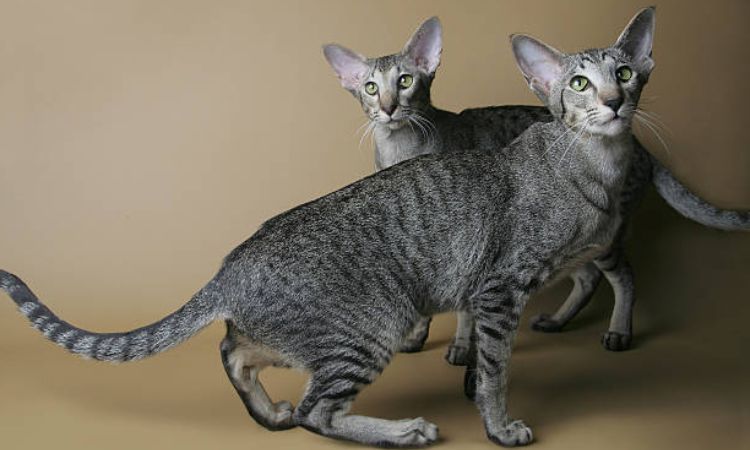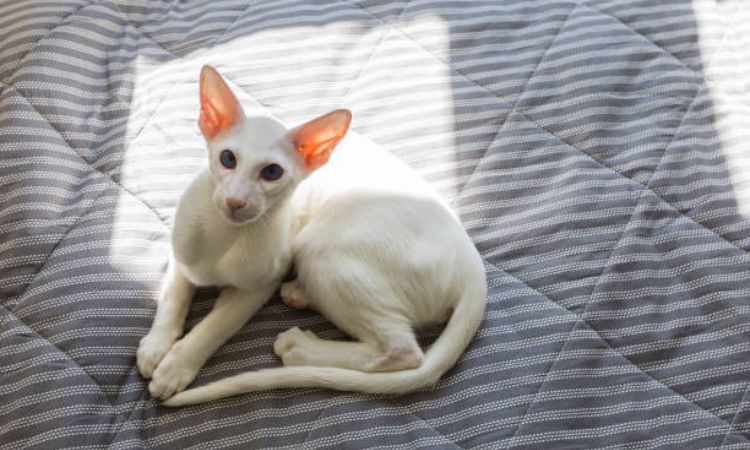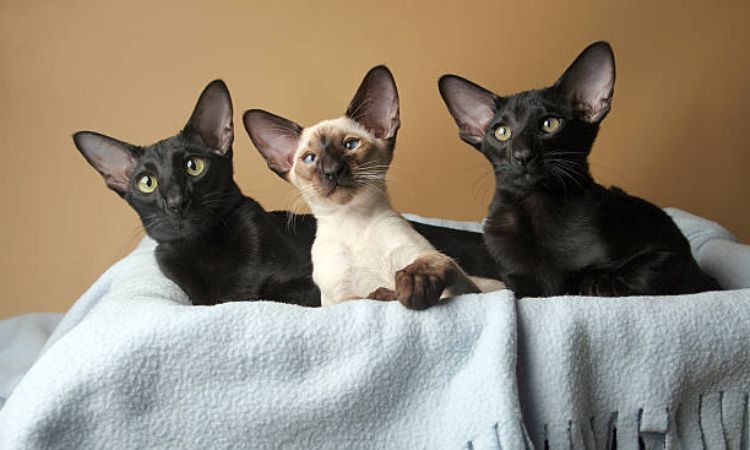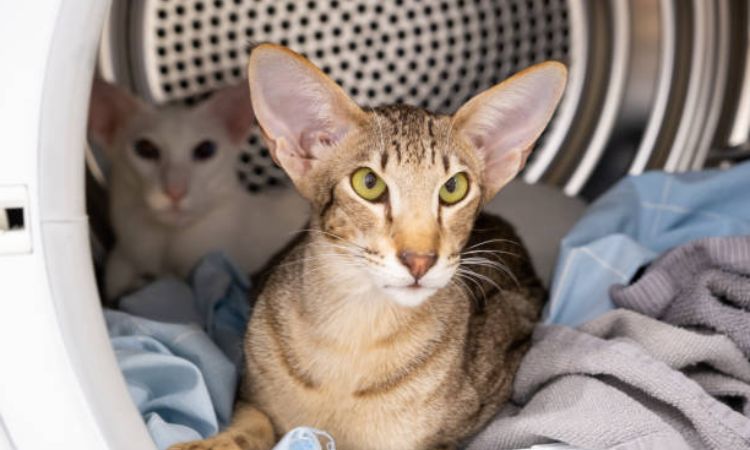Sleek, striking, and full of character, the Oriental Shorthair turns heads wherever it goes. With its almond-shaped eyes, elegant triangular face, and long, toned physique, this breed combines beauty with brains.
Curious, playful, and endlessly social, Oriental Shorthairs thrive in lively homes where they can show off their personality. In this guide from Nexus Pets, we’ll explore everything you need to know about their price, temperament, size, and fascinating origins.

Origin and History
The Oriental Shorthair traces its roots back to the landrace cats of Thailand, the same ancestral stock that gave rise to the Siamese. While the modern breed was developed in the United States during the early 1970s, its genetic foundation includes not only Siamese cats but also other breeds such as Russian Blues, Abyssinians, British Shorthairs, and select domestic cats. Breeders aimed to preserve the elegant, elongated body type and outgoing, social personality of the Siamese while expanding the range of coat colors and patterns beyond the traditional pointed varieties.
The breed’s formal development began when New York-area breeders—including Vicky and Peter Markstein—recognized the potential of solid-colored and patterned cats with Siamese body type. These cats were selectively bred to emphasize the slender, athletic build, wedge-shaped head, large ears, and almond-shaped eyes characteristic of the Oriental type, while introducing hundreds of coat variations. Over time, the Oriental Shorthair emerged as a distinct breed, maintaining the intelligence, vocal nature, and playful energy of its Siamese relatives.
The Oriental Shorthair gained official recognition from major cat associations in the 1970s. The Cat Fanciers’ Association (CFA) accepted the breed for championship competition in 1977, followed by recognition from other international registries including the Governing Council of the Cat Fancy (GCCF) in 1997 and the World Cat Federation (WCF). Depending on the registry, the breed may be classified either as a standalone breed or as a division of the broader Oriental group. Its close relation to the Siamese is evident in both physical traits and temperament, yet the Oriental Shorthair stands out due to its unparalleled diversity in colors and patterns.
Physical Characteristics and Size
Oriental Shorthairs are a medium-sized, athletic breed, celebrated for their elegant and sleek physique. Their body is long, slender, and muscular, giving the impression of strength without bulk. Every aspect of their form—from head to tail—is designed to create a graceful, streamlined silhouette.
Head and Face
- Shape: Triangular wedge with a long, straight profile.
- Eyes: Almond-shaped, slightly slanted, usually green (blue in pointed variants), giving a striking, expressive appearance.
- Ears: Large, wide at the base, and set to continue the triangular lines of the head.
Body and Limbs
- Neck: Long and elegant, flowing seamlessly into the shoulders.
- Torso: Tubular and muscular, maintaining a sleek and agile build.
- Legs: Long and slim, with hind legs slightly longer than the forelegs.
- Paws: Small, dainty, and oval-shaped, complementing their refined form.
Tail
- Shape: Long, thin, and tapering to a fine point.
- Coat: Short, fine, and close-lying to the body, emphasizing their lean frame.
Size
- Weight: Males typically 8–12 lbs (3.6–5.4 kg); females slightly smaller.
- Build: Medium-sized, yet athletic and highly agile, ideal for climbing, jumping, and active play.
Oriental Shorthairs’ combination of elegance, musculature, and athleticism makes them one of the most visually striking and agile domestic cats.

Personality and Temperament
Oriental Shorthairs are known for their lively, affectionate, and social personalities. These cats are incredibly people-oriented and thrive on attention from their human companions. Here’s a deeper look into their character:
Affectionate and Bonded
Much like their Siamese relatives, Oriental Shorthairs quickly form strong bonds with their families. They are loyal and devoted, and are often described as being “dog-like” in their desire to stay close to their human companions. Expect your Oriental Shorthair to follow you around the house and actively seek out attention, whether it’s cuddling on your lap, playing, or just being in the same room.
Vocal and Communicative
Orientals are extremely vocal cats. They love to “talk,” and their voices can range from soft chirps to more demanding meows. These cats are naturally curious, so they’ll express their thoughts, whether they’re asking for food, attention, or simply sharing their observations. Their vocalizations are often described as expressive and conversational, and they are known for having a distinct way of “chatting” with their owners.
Highly Playful and Energetic
This breed is highly energetic, often maintaining a kitten-like playfulness well into adulthood. They enjoy active playtime, especially interactive games that engage their minds, such as fetch or puzzle toys. Oriental Shorthairs are athletic, excelling at jumping, climbing, and exploring, so providing them with climbing trees and shelves will keep them entertained. Their playful nature means they need regular physical exercise and mental stimulation to stay happy and avoid boredom-induced mischief.
Curious and Intelligent
Oriental Shorthairs are extremely intelligent and have a strong need to explore their environment. They are quick learners and enjoy figuring out new things. This intelligence, combined with their natural curiosity, makes them adept at solving problems—so be sure to keep your home cat-proofed if you want to avoid any unintended “explorations” into cabinets or shelves! Their curiosity can also translate into eagerness to learn tricks, making them one of the easiest breeds to train with positive reinforcement.
Sociable and Friendly
Oriental Shorthairs are social butterflies. They tend to do well in multi-pet households and often enjoy the company of other cats and even dogs. They’re not shy with guests and will happily make friends with anyone who walks through the door. Their outgoing nature makes them excellent companions for families, children, and even people who are new to cats.
Affectionate but Independent
While they love being around people, Oriental Shorthairs are also independent thinkers. They won’t demand constant attention like some breeds, but they do want regular interaction and will seek attention on their terms. Their balance of affectionate attachment and independence makes them a great choice for people who want a companion that is both social and self-sufficient.
Care and Grooming

Coat Care: Minimal Grooming for a Sleek Look
Oriental Shorthairs are known for their short, fine, and glossy coats, which lie close to their slender bodies, highlighting their elegant and athletic build. Their lack of an undercoat means they shed less than many other breeds, making them an ideal choice for those with mild allergies or who prefer low-maintenance grooming.
- Brushing: Despite their short coat, regular brushing is still beneficial. Brushing your Oriental Shorthair once a week with a soft-bristle brush or grooming mitt will help remove loose hair and keep their coat looking sleek and shiny. This also helps to spread natural oils through their fur, keeping it smooth and lustrous.
- Bathing: Oriental Shorthairs are generally very clean and do not require frequent baths. However, if they get into something messy or are shedding excessively, an occasional bath with a gentle, cat-safe shampoo can help keep their skin and coat in top condition. Always rinse thoroughly to avoid residue buildup, which could irritate their skin.
Ear Care: Keep Those Perky Ears Clean
One of the most striking features of the Oriental Shorthair is its large, perky ears. While they don’t require intensive ear care, regular checks are necessary to avoid the buildup of wax or dirt, which could lead to infections.
- Routine Checks: Inspect your cat’s ears weekly for any signs of dirt, wax, or discharge. If you notice any dark spots resembling coffee grounds or a foul odor, it may indicate an ear infection or the presence of mites. In such cases, consult your vet for appropriate treatment.
- Cleaning: Use a vet-approved ear cleaner and a cotton ball or gauze to gently clean the outer ear. Avoid using cotton swabs, as they can push debris deeper into the ear canal and cause injury.
Eye Care: A Beautiful, Wedge-Shaped Face
The Oriental Shorthair’s almond-shaped eyes are one of its most distinguishing features. They should be bright, clear, and free from excessive discharge.
- Cleaning: Though their eyes don’t require much attention, it’s a good idea to check them regularly for any signs of abnormal discharge. If you notice any crusty or sticky substances around their eyes, gently wipe them with a damp cotton ball. Always use a clean part of the cotton ball for each eye to avoid cross-contamination.
- Vision Loss: Be alert to signs of vision loss, such as bumping into objects or becoming less responsive to visual cues. If you notice these signs, a veterinary visit is recommended to rule out any issues like hereditary retinal degeneration, which the breed may be predisposed to.
Dental Care: Preventing Dental Issues
Dental health is crucial for Oriental Shorthairs as they are prone to gingivitis, periodontal disease, and tartar buildup due to their jaw structure.
- Brushing: Make sure to brush your cat’s teeth several times a week with a cat-specific toothbrush and toothpaste. Regular brushing helps remove plaque before it hardens into tartar and prevents gum disease. You can start slowly by gently massaging their gums and introducing the toothbrush at a comfortable pace.
- Dental Treats and Toys: Offering dental treats and specially designed chew toys can help reduce plaque buildup. These treats can also make brushing easier, as cats often love the taste and texture.
- Regular Vet Check-ups: Schedule regular dental check-ups with your vet. Professional cleanings may be required, depending on the amount of tartar buildup.
Nail Trimming: Keep Claws in Check
Like all cats, Oriental Shorthairs need their nails trimmed regularly to prevent them from becoming overgrown or causing injury to themselves or others.
- Trimming Frequency: Trim your cat’s nails every 2-3 weeks to keep them at a healthy length. Use cat-specific nail clippers, and be sure to trim only the sharp tips. Avoid cutting into the pink area of the nail (the quick), which can be painful and cause bleeding.
- Scratching Posts: Provide scratching posts or pads for your Oriental Shorthair to help keep their claws sharp and healthy. Scratching is a natural behavior that helps them shed the outer layers of their claws and mark territory.
Skin Care: Keeping Their Skin Healthy
Although the Oriental Shorthair doesn’t have a thick undercoat, its skin can still be sensitive. To help keep their skin in top shape:
- Balanced Diet: Ensure your Oriental Shorthair is eating a high-quality, nutritionally balanced diet rich in omega-3 and omega-6 fatty acids, which support healthy skin and coat. A shiny coat is often an indicator of good health.
- Allergy Awareness: Be mindful of any signs of skin irritation, such as excessive scratching, redness, or dry patches. If these symptoms occur, consult your vet to rule out allergies or skin conditions.
Exercise and Mental Stimulation
While grooming keeps your cat physically healthy, mental stimulation and exercise are crucial to keeping them happy and well-adjusted.
- Playtime: Oriental Shorthairs are energetic and require plenty of play to keep their minds sharp. Interactive toys like feather wands, laser pointers, and puzzle feeders are great for stimulating their intellect and offering physical exercise.
- Climbing Spaces: Provide plenty of climbing trees, shelves, and perches to satisfy their natural instincts to explore high places. These will keep them entertained and active, which is essential for their well-being.
Price and Where to Buy

Average Cost of Oriental Shorthair Kittens
The price of an Oriental Shorthair kitten can vary widely depending on factors such as pedigree, breeder reputation, and location. On average, you can expect to pay between $600 and $1,500 for a kitten from a reputable breeder. Some rare color variations or show-quality kittens may even exceed $2,000.
Factors Influencing Price
Several key factors determine the cost of an Oriental Shorthair:
- Pedigree and Lineage: Kittens from award-winning show lines or from parents with documented health clearances typically cost more.
- Breeder Reputation: Experienced and responsible breeders who perform genetic testing, maintain high standards of care, and provide early socialization often charge higher prices.
- Color and Pattern: Certain colors or patterns, such as rare bicolor or unusual coat variations, may increase a kitten’s price due to their scarcity.
- Location: Prices can vary by region or country due to local demand and availability.
Finding Responsible Breeders or Adoption Options
When looking for an Oriental Shorthair, it’s crucial to prioritize the health and well-being of the cat over price alone. Here are some tips:
- Research Reputable Breeders: Seek breeders affiliated with recognized cat registries such as the Cat Fanciers’ Association (CFA) or The International Cat Association (TICA). Ensure they perform genetic testing for common breed health issues like amyloidosis and hereditary retinal degeneration.
- Visit the Breeder: Observe the living conditions, cleanliness, and socialization of kittens. A responsible breeder will allow you to meet the kittens and their parents.
- Ask for Health Records: Reputable breeders provide veterinary records, vaccination history, and information about potential hereditary conditions.
- Consider Adoption: While purebred Oriental Shorthairs are less common in shelters, some rescues may have cats that are either confirmed or resemble the breed. Websites like Petfinder can help you locate available cats. Adopting a rescue cat can be a fulfilling option while providing a loving home to a cat in need.
By taking the time to research breeders or consider adoption, you can ensure that your Oriental Shorthair will come from a healthy, well-socialized, and ethically raised environment, giving you the best chance for a long, happy companionship.
Welcoming an Oriental Shorthair into your home brings a cat that is as striking as it is affectionate. With their vibrant coat patterns, athletic build, and curious, social personality, these cats thrive in environments where they receive attention, play, and mental stimulation. Knowing their origins, temperament, and care needs—as well as choosing a responsible breeder or adoption option—helps ensure your Oriental Shorthair enjoys a healthy, happy life while forming a strong, lasting bond with you.






